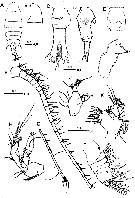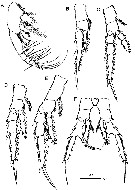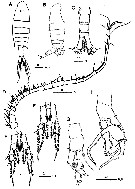|
|
 |
Fiche d'espèce de Copépode |
|
|
Calanoida ( Ordre ) |
|
|
|
Diaptomoidea ( Superfamille ) |
|
|
|
Centropagidae ( Famille ) |
|
|
|
Centropages ( Genre ) |
|
|
| |
Centropages aegypticus El-Sherbiny & Ueda, 2008 (F,M) | |
| | | | | | | Ref.: | | | El-Sherbiny & Ueda, 2008 (p.69, figs.F,M) |  issued from : M.M. El-Sherbiny & H. Ueda in J. Mar. Biol. Ass. U.K., 2008, 88 (1). [p.70, Fig.1]. Female (from 27°51'39\"N, 34°17'53\"E): A, habitus (dorsal); B, cephalosome (lateral); C-D, urosome (dorsal and lateral, respectively); E, genital compound somite (ventral); F-G, A1; H, A2; I, Md (mandibular gnathobase); J, Md (mandibular palp); K, Mx1; L, Mx2. Scale bars in mm. Nota: Rostrum bearing pair of long filaments with broad bases. Genital compound somite asymmetrical, with irregular surface outline swelling on right side and 2 transverse rows of spinules at midlength, anterior short row of them dorsally and posterior long one dorsolaterally on left side, genital operculum located half way along ventral surface. Caudal rami symmetrical and approximately 3.5 times as long as wide. A1 24-segmented, exceeds the caudal rami by the last 4 segments. A2 with short coxa bearing plumose seta, basis with 2 suequal terminal setae; exopod indistinctly 7-segmented with setal formula of 1, 2, 1, 1, 1, 1, 1 + 3; endopod 2-segmented. Md with 8 cuspate teeth and spinulose seta along the coxal cutting edge; basis bearing 4 medial setae at midlength; exopod 5-segmented with setal formula of 0, 1, 1, 1, 2; endopod 2segmented, carrying 4 setae at distal corner of proximal segment and 9 setae and 2 rows of fine spinules anteriorally on distal segment. Mx1 with 15 setae on praecoxal arthrite; coxa bearing 7 well developed and short proximal seta on epipodite and 3 setae on endite; basis completely fused to endopod, exite with seta and 1st and 2nd endites with 4 and 5 setae, respectively; endopod indistinctly 2-segmented, bearing 6 setae along the medial margin of proximal segment and 3 setae on distal segment; exopod with 9 lateral setae. mx2 praecoxal endites with 4, 3 setae, coxal endites with 3, 3 setae, basal endite with 2 strong and 1 short slender setae, endopod with 8 setae.
|
 issued from : M.M. El-Sherbiny & H. Ueda in J. Mar. Biol. Ass. U.K., 2008, 88 (1). [p.71, Fig.2]. Female: A, Mxp; B-F, P1 to P5. Scale bar in mm.
|
 issued from : M.M. El-Sherbiny & H. Ueda in J. Mar. Biol. Ass. U.K., 2008, 88 (1). [p.73, Fig.4]. Female: A-C, variations in the genital compound somite. Scale bar in mm. Nota: The shape and number of spinule row varied among individuals. For example, some specimens had long but intermittent anterior row dorsolaterally on the left side, and another one had only a single row.
|
 issued from : M.M. El-Sherbiny & H. Ueda in J. Mar. Biol. Ass. U.K., 2008, 88 (1). [p.72, Fig.3]. Male: A-B, habitus (dorsal and lateral, respectively); C, urosome (dorsal); D, right A1; E, P3; F, P4; G, left P5 (posterior view); H, right P5 (posterior view). Scale bars in mm. Nota: Right A1 geniculate, 22-segmented. Mouthpart appendages, P1 and P2 as in female
|
 issued from : M.M. El-Sherbiny & H. Ueda in J. Mar. Biol. Ass. U.K., 2008, 88 (1). [p.73, Table 1]. Spine (Roman numerals) and setal (arabic numerals) formula of swimming legs.
| | | | | NZ: | 1 | | |
|
Carte de distribution de Centropages aegypticus par zones géographiques
|
| | | | Loc: | | | N Red Sea (Sharm El-Maya: Sharm El-Sheikh) | | | | N: | 1 | | | | Lg.: | | | (988) F: 1,5-1,67; M: 1,5-1,70; {F: 1,50-1,67; M: 1,50-1,70} | | | | Rem.: | Shallow and semi-enclosed bay (sample :depth 2,5 m).
According to El-Sherbiny & Ueda (2008, p.74) this species in spite of the similarity to Centropages tenuiremis does not belons to the "hamatus" Group". One may consider Centropages dorsispinatus Thompson & Scott (1903) of the "typicus Group as an another simolar species because both species have a prominent dorsal spine on both the female and male cephalosome. In conclusion, C. aegypticus does not belong to existing species group defined by Vervoort (1964) and Ohtsuka & al. (2003, 2005). | | | Dernière mise à jour : 31/12/2014 | |
|
|
 Toute utilisation de ce site pour une publication sera mentionnée avec la référence suivante : Toute utilisation de ce site pour une publication sera mentionnée avec la référence suivante :
Razouls C., Desreumaux N., Kouwenberg J. et de Bovée F., 2005-2024. - Biodiversité des Copépodes planctoniques marins (morphologie, répartition géographique et données biologiques). Sorbonne Université, CNRS. Disponible sur http://copepodes.obs-banyuls.fr [Accédé le 25 avril 2024] © copyright 2005-2024 Sorbonne Université, CNRS
|
|
 |
 |






